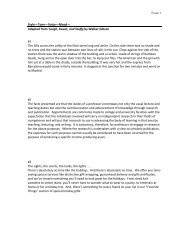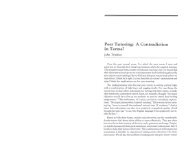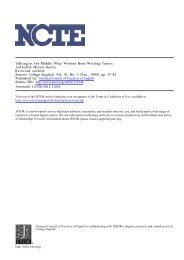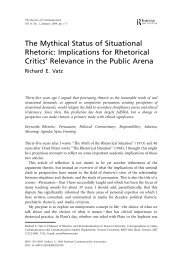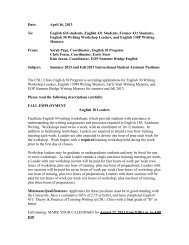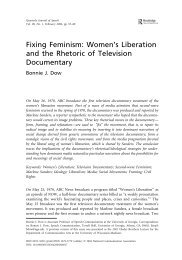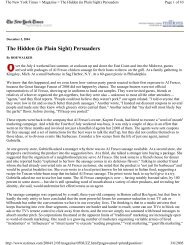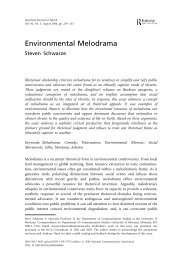Perelman, ad Hominem Argument, and Rhetorical ... - CompHacker
Perelman, ad Hominem Argument, and Rhetorical ... - CompHacker
Perelman, ad Hominem Argument, and Rhetorical ... - CompHacker
You also want an ePaper? Increase the reach of your titles
YUMPU automatically turns print PDFs into web optimized ePapers that Google loves.
304 M. Lefflengthy treatise entirely devoted to <strong>ad</strong> hominem, Walton generates a complextypology of <strong>ad</strong> hominem schemes <strong>and</strong> offers norms for evaluating them (Walton1998).The differences among these positions are significant, <strong>and</strong> the second <strong>and</strong> thirdarise from within a complex program for argumentation studies that includesimportant rhetorical considerations. Nevertheless, all three bear a family resemblancethat discloses a common dialectical paternity, <strong>and</strong> the nature <strong>and</strong> significanceof that commonality emerges when we contrast dialectical <strong>and</strong> rhetoricalorientations toward the treatment of persons in argumentation. At the same time,this contrast also provides insight into <strong>Perelman</strong>’s thought <strong>and</strong> suggests someproblems that emerge in <strong>Perelman</strong>’s theory as it weaves between the borders ofrhetoric <strong>and</strong> dialectic.Brinton (1985, 1986, 1995) <strong>and</strong> Amossy (2001) have both noted that ethos inrhetoric is the counterpart of <strong>ad</strong> hominem in dialectical, <strong>and</strong> by borrowing <strong>and</strong>exp<strong>and</strong>ing their analyses, we can place these two sister concepts in a relationship toone another that reveals four main points of contrast:1. Dialectical <strong>ad</strong> hominem dwells in the negative <strong>and</strong> deals with the Thou ShaltNots of argument. It identifies argumentative missteps that speakers shouldavoid <strong>and</strong> that hearers should be able to identify <strong>and</strong> expose. <strong>Rhetorical</strong> ethosfunctions as a resource for invention. It offers possibilities for speakers toconstruct favorable images of themselves, unfavorable images of opponents,<strong>and</strong> to do whatever else <strong>ad</strong>vances their purpose through reference to persons.2. Contemporary dialecticians treat <strong>ad</strong> hominem argument as part of a socialinteraction, but they limit the interaction to the argumentative exchange per se<strong>and</strong> its explicitly stated assertions. Bro<strong>ad</strong>er aspects of the context that link withsocial, cultural or intertextual matters get bracketed. But in rhetoric thesematters are crucial, since, as Brinton says, the goal is for the speaker to embody‘‘the general ethos (character) of the society’’, <strong>and</strong> so the speaker seeks ‘‘toexpress our shared values, to think in terms of our common assumptions, toexercise good judgment, <strong>and</strong> to speak for us’’ (Brinton 1985, p. 55).3. Dialecticians assess credibility <strong>and</strong> authority in relation to the relevance <strong>and</strong>force of assertions m<strong>ad</strong>e about persons. Rhetoricians consider both what is said<strong>and</strong> how it is said <strong>and</strong> often study credibility (or its opposite) as somethingenacted when speakers construct character-traits or character-types throughdiscursive performance.4. The goal of dialectic is to establish general criteria for assessing justified beliefor processes that justifiably resolve disputes, <strong>and</strong> as a consequence, dialecticalinquiry gravitates toward abstract types <strong>and</strong> structures of argument. In the caseof <strong>ad</strong> hominem, this le<strong>ad</strong>s to considerable effort in defining its characteristics,breaking it into species (e.g., direct, circumstantial, tu quoque, etc.), <strong>and</strong>specifying norms for assessing its variants as they appear in different phases ofargumentation or in discussions with different purposes (with both phases <strong>and</strong>purposes stipulated in abstract schemes). The goal of rhetoric is to develop acapacity for using <strong>and</strong> underst<strong>and</strong>ing argument in action, <strong>and</strong> as a result,rhetoricians tend to treat types <strong>and</strong> structures of argument opportunistically,123
<strong>Perelman</strong>, <strong>ad</strong> <strong>Hominem</strong> <strong>Argument</strong> 305turning them to their purposes as they engage particular cases <strong>and</strong> <strong>ad</strong>dressspecific audiences.<strong>Perelman</strong>, as we all know, quite consciously selects rhetoric <strong>and</strong> not dialectic asthe title for his project, <strong>and</strong> the contrasts I have just cited correspond to some of thereasons that explain his choice, since they underscore the rhetorical emphasis onargument as a situated act closely connected to an audience. In a passage I quotedearlier, <strong>Perelman</strong> makes it abundantly clear that he regards argument as related toaction that manifests itself in socially <strong>and</strong> psychologically determined situations,<strong>and</strong> for this reason, he insists that it entails interaction between <strong>and</strong> commitmentfrom the parties involved in argument <strong>and</strong> that what an arguer asserts cannot bedetached from the ‘‘person who makes it.’’ In these respects, <strong>Perelman</strong> not onlybreaks decisively away from the formalist model, but he also pushes beyond thelimits of informal logic <strong>and</strong> dialectic. 4Yet, the New Rhetoric does not provide the kind of dense <strong>and</strong> rhetoricallynuanced account of the role of persons in argument that <strong>Perelman</strong>’s commitmentsmight seem to require. The book makes only a brief <strong>and</strong> passing reference to theconcept of ethos, <strong>and</strong> the detailed analysis of act <strong>and</strong> person in argument (Part III,sections 68–73) re<strong>ad</strong>s like an inventory of tactics rather than a theory of howarguments relate to <strong>and</strong> make use of the person of the arguer. The key to thisanomaly, I believe, is found in the section devoted to the ‘‘Speech as an Act of theSpeaker’’ (III, 72), <strong>and</strong> I will soon turn to that section <strong>and</strong> give it close attention.Before doing so, I need to acknowledge that <strong>Perelman</strong> <strong>ad</strong>dresses the issue of <strong>ad</strong>hominem argument in a compact <strong>and</strong> interesting section near the end of hisdiscussion of agreement as a starting point for argument (II, 28: 100–114).<strong>Perelman</strong> observes that, within his conception of argumentation, all argumentsare ex concessis or <strong>ad</strong> hominem. Whereas logicians distinguish between <strong>ad</strong>hominem arguments, which are based human opinion, <strong>and</strong> <strong>ad</strong> rem arguments, whichare based on fact, <strong>Perelman</strong> regards facts as nothing other than points of agreementthat refer to the universal audience, <strong>and</strong> hence what others consider <strong>ad</strong> rem premisesare, for him, only a particular species of premises drawn from the agreement of theaudience. Moreover, since arguments directed toward the universal audience claimvalidity for all rational beings, <strong>Perelman</strong> suggests that we should call sucharguments <strong>ad</strong> humanitatem <strong>and</strong> consider them as a special class of <strong>ad</strong> hominemargument. But he almost immediately modifies this distinction by offering a view of<strong>ad</strong> hominem in a ‘‘narrow sense’’ that would only apply to instances in whichspeakers <strong>ad</strong>vance arguments that they know ‘‘to be without weight for the universalaudience.’’ This is an intriguing concept, but <strong>Perelman</strong> offers no explanation otherthan to give a short example, <strong>and</strong> he concludes his discussion with yet anotherdistinction. This time he separates argument <strong>ad</strong> hominem from argument <strong>ad</strong>personam because the former deals with consistency or inconsistency in the beliefsof a particular audience, while latter involves a personal attack intended to discreditan opponent.4 Concerning this difference, see, for example, Van Eemeren <strong>and</strong> Grootendurst (1995b).123
306 M. LeffI find these observations both richly suggestive <strong>and</strong> bewildering. In about twopages of text, <strong>Perelman</strong> spills out an array of terms, some of them representing noveltwists on familiar definitions <strong>and</strong> conceptions, which suggest intriguing ways toreconsider the whole tribe of <strong>ad</strong> hominem appeals <strong>and</strong> to distinguish their rhetoricalincarnations from their manifestation in other guises. But since he does not flesh outany of his terminological maneuvers, the discussion seems incidental, <strong>and</strong> it has noapparent connection with the later <strong>and</strong> more extensive analysis of act <strong>and</strong> person inargument.That analysis appears in Part III <strong>and</strong> covers 35 pages divided into 6 he<strong>ad</strong>ings. Thewhole of this discussion merits careful study by anyone interested in argumentsbased on the character <strong>and</strong> status of arguers, but for present purposes, I have timenow to deal with just one of the he<strong>ad</strong>ings—’’The Speech as an Act of the Speaker’’(Sect. 72). It is here that <strong>Perelman</strong> touches most directly on the concept of ethos <strong>and</strong>makes his sole explicit reference to the concept.The section begins by emphasizing the interaction between speaker <strong>and</strong> speech<strong>and</strong> makes the claim that it ‘‘is perhaps the most characteristic part of argumentationas opposed to demonstration’’ (317). Even with the qualifying ‘‘perhaps’’, this is astrong assertion, <strong>and</strong> we might expect some amplification or justification. Inste<strong>ad</strong>,however, <strong>Perelman</strong> proceeds, as he does elsewhere in the treatise, to cataloguetechniques <strong>and</strong> strategies of argument <strong>and</strong> to offer caveats about their use. Some ofthese refer to st<strong>and</strong>ard techniques for ethotic argument such as the need to gain therespect, goodwill, <strong>and</strong> sympathy of the audience <strong>and</strong> the corresponding effort todiscredit the character of <strong>ad</strong>versaries, but a number of his points incorporate <strong>and</strong>stress rather specific performative considerations—e.g., the quality of a speaker’sargument influences the audience’s perception of the speaker; the speaker shouldconciliate the audience by demonstrating trust in its judgment; the speaker, whomust often act as mentor, should take care not stir up hostility toward himself bytreating the audience as though it is inferior; <strong>and</strong> the speaker should display a properattitude toward hearers by exercising restraint, discretion, <strong>and</strong> brevity <strong>and</strong> byavoiding arrogant displays of knowledge. These matters all refer to the situatedconduct of an arguer <strong>and</strong> his or her interaction with a specific audience, <strong>and</strong> theyindicate the limits of propositional analysis or abstract norms as st<strong>and</strong>ards forassessing the use of ethotic arguments, since neither propositions nor abstract normscan explain how a speaker establishes rapport with an audience in a particular case.Consequently, such observations about style <strong>and</strong> demeanor directly follow from <strong>and</strong>support <strong>Perelman</strong>’s claim that the speaker/speech interaction plays marks a crucialpoint of distinction between argumentation <strong>and</strong> formal logic. Yet, he does notamplify, illustrate, or reflect on any of these points, <strong>and</strong> he does not connect themwith his opening claim. Why not?No doubt, part of the reason comes from the plan of the New Rhetoric, whichsweeps through vast tracts of rhetorical lore so rapidly that little time is available forreflective moments. A less obvious, but perhaps more interesting reason, however,surfaces if we examine the one passage where <strong>Perelman</strong> explicitly mentions <strong>and</strong>defines the concept of ethos: ‘‘What the ancients used to call oratorical ethos can besummed up as the impression which the speaker, by means of his words, gives ofhimself. Isocrates has this to say: ‘Never support to defend a b<strong>ad</strong> cause, for the123
<strong>Perelman</strong>, <strong>ad</strong> <strong>Hominem</strong> <strong>Argument</strong> 307people will suspect that you yourself do the things which you aid others in doing’’’(319). This passage is somewhat confusing, <strong>and</strong> one of the problems is that itconflates two quite different versions of ethos. The first is Aristotelian, which treatsethos as a mode of proof entirely limited to the words uttered by the speaker. Thesecond is Isocratean, which incorporates the reputation of the speaker based uponthings said <strong>and</strong> done before beginning the speech.The specific, technical confusion is easily clarified, but the passage evidences amore fundamental problem about underst<strong>and</strong>ing the rhetorical tr<strong>ad</strong>ition. Here aselsewhere, <strong>Perelman</strong>, regards that tr<strong>ad</strong>ition as a seamless whole, <strong>and</strong> while this viewis not uncommon, it is also inaccurate. Classical rhetoric includes several variants,two of the most prominent of them being represented, on one side, by Aristotle, <strong>and</strong>on the other, by a tr<strong>ad</strong>ition that stretches from Isocrates to Cicero <strong>and</strong> Quintilian,<strong>and</strong> from there to the Renaissance humanists. 5 Aristotle stresses the status ofrhetoric as an art <strong>and</strong> conceives rhetoric as a body of precepts organized in a more orless systematic fashion <strong>and</strong> directed toward discovering the means of persuasion.The other position, which Janet Atwill aptly calls the ‘‘eloquence tr<strong>ad</strong>ition,’’ (1998)places emphasis on the person of the orator, regards the ‘‘art’’ as a useful butancillary part of the enterprise, <strong>and</strong> seeks its end in developing the flexible capacityto respond appropriately to the circumstances of particular cases.The general difference between these perspectives determines their conceptionsof ethotic arguments. The Aristotelian identifies techniques a speaker can use in theartistic construction of character but brackets contextual issues such as priorreputation because they are extrinsic to the art. The Isocratean seeks to underst<strong>and</strong>how to enact character in a particular case, <strong>and</strong> for this purpose, extrinsic concerns,such as prior reputation, necessarily enter into the equation, <strong>and</strong> knowledge oftechniques is regarded as less instructive than practice <strong>and</strong> the study of models.<strong>Perelman</strong> is hardly insensitive to the social <strong>and</strong> cultural dimensions ofargumentation, <strong>and</strong> as we have just noted, he openly acknowledges thatperformance is crucially important in the argumentative process. On the whole,however, his attitude is Aristotelian. He explains in the introduction of the NewRhetoric that his project ‘‘is mainly concerned with the structure of argumentation,’’<strong>and</strong> so it ‘‘will not therefore insist on the way in which communication with theaudience takes place’’ (6). And indeed the book methodically identifies <strong>and</strong>explicates argumentative structures <strong>and</strong> techniques–<strong>and</strong> does so very effectively—but it does not provide thick descriptions of rhetorical practice; it does not show howthe argumentative techniques work as part of an integrated persuasive effort. As in <strong>ad</strong>ialectical treatise, examples, even when extended, serve to illustrate principlesrather than to stimulate heuristic insight or to serve as models for imitation.Given <strong>Perelman</strong>’s commitment to argument as situated action, it would seemimportant for him to supplement his Aristotelian scheme with an Isocratean interestin the workings of argument as it is actually conducted. That he does not do soopens a gap between his conception of the rhetorical tr<strong>ad</strong>ition <strong>and</strong> its representationin the New Rhetoric. The problem, most certainly, is not a failure to deal with themain task he sets before himself, which is to provide a comprehensive <strong>and</strong> updated5 Concerning the variations in classical rhetoric, see Conley (1990, pp. 4–25).123
308 M. Lefftreatment of the techniques of rhetorical argument. Rather it is a failure to recognizethat the techniques provide only part of what is needed in order to underst<strong>and</strong> howarguments behave. And 50 years after <strong>Perelman</strong>, I believe that we can most usefully<strong>ad</strong>vance his project by getting down to cases, <strong>and</strong> that is what I propose to do inconcluding this paper.Ruth Amossy (2001, p. 3), based on her own study of cases, has explained thatone of the key problems related to ethos has to do with underst<strong>and</strong>ing who has theauthority to speak within a specific set of circumstances—or to use her metaphor—who is allowed to hold the skeptron. The case I have chosen raises that issue in aparticularly vivid way, since it concerns a writer who belongs to a marginalizedclass <strong>and</strong> who uses ethotic argument to find a voice that remains distinctive butsufficiently <strong>ad</strong>apted to the dominant culture to win an audience.In his essay, ‘‘Of Booker T. Washington <strong>and</strong> Others’’ (published in 1903 as achapter in Souls of the Black Folk), W.E.B. Du Bois attempted to chart a politicalprogram for African–Americans at troubled moment in their history. Subjected tothe racist ‘‘Jim Crow’’ laws in the South <strong>and</strong> systematic economic <strong>and</strong> socialexploitation throughout the nation, African–Americans were denied a meaningfulvoice in public deliberation <strong>and</strong> virtually excluded from political power. Only oneamong them–Booker T. Washington–h<strong>ad</strong> managed to gain recognition from thewhite establishment <strong>and</strong> the opportunity to speak across the racial divide.Washington, however, employed a rhetoric so thoroughly blended into theprevailing idiom of the white world that it seemed indistinguishable from it.Du Bois found Washington’s influence confining <strong>and</strong> sought to articulate astronger, more independent, <strong>and</strong> more critical message both to <strong>and</strong> from the Blackcommunity. To do so, however, he h<strong>ad</strong> to find a rhetorical vehicle for expressingdissent in a public sphere which then did not yet allow a public platform for AfricanAmerican dissent. In his essay, Du Bois sought to resolve this problem by workingthrough <strong>and</strong> against the grain of Washington’s constraining but authoritative ethos.The first three sentences of the essay subtly prefigure Du Bois’ purpose <strong>and</strong>strategy. They re<strong>ad</strong>: ‘‘Easily the most striking thing in the history of the AmericanNegro since 1876 is the ascendancy of Mr. Booker T. Washington. It began at thetime when war memories <strong>and</strong> ideals were rapidly passing; a day of astonishingcommercial development was dawning; a sense of doubt <strong>and</strong> hesitation overtook thefreedmen’s sons,–then it was that his le<strong>ad</strong>ing began. Mr. Washington came, with asingle definite programme, at the psychological moment when the nation was a littleashamed of having bestowed so much sentiment on Negroes, <strong>and</strong> was concentratingits energies on Dollars’’ (Du Bois 1989, p. 30).The opening sentence establishes a narrative voice of for the author that isdistanced <strong>and</strong> removed from momentary distractions as it sweeps over a bro<strong>ad</strong>historical vista, <strong>and</strong> the style is impersonal, ac<strong>ad</strong>emic, clinically diagnostic. Fromthis vantage point, what strikes Du Bois is not Washington’s role as an agent, as anactive le<strong>ad</strong>er, but his inert placement along the historical l<strong>and</strong>scape–his emergenceis not even an event, but a ‘‘thing’’. The impersonal <strong>and</strong> indirect construction of thesentence strongly suggests Washington’s passivity. Consider how different its forcewould be if it were cast in more active, <strong>and</strong> perhaps more normal, syntax, so that itwould re<strong>ad</strong>: ‘‘Mr. Booker T. Washington’s ascendancy is easily the most striking123
<strong>Perelman</strong>, <strong>ad</strong> <strong>Hominem</strong> <strong>Argument</strong> 309thing in the history of the American Negro since 1876.’’ In Du Bois’s version, bycontrast, Washington’s name emerges only at the end of the sentence, insulatedfrom the verb by a preposition, <strong>and</strong> his ascendancy appears less as the result ofsomeone acting in history than as something that simply happened in history.Finally, the temporal frame that Du Bois uses is rhetorically significant. Washingtonis viewed from within the context of events that have occurred since 1876–that is,since the end of Reconstruction <strong>and</strong> <strong>ad</strong>vent of Jim Crow–a low-point in African–American history. Washington’s ascendancy, then, corresponds with a regression inthe fate of his people.Passing over the second sentence for the moment, we can note that the thirdpresents Washington as a more active agent. Here his name appears at the beginningof the sentence <strong>and</strong> in the nominative position. But the stress falls not on whatWashington did, but upon the moment when he came on the scene. He was simplyin the right place at the right time, <strong>and</strong> insofar as he engaged in any independentaction, it was to ‘‘put forward a single definite programme’’ that was suited to thecircumstances. Washington, then, remains an essentially reactive figure; hisprogram <strong>ad</strong>justs to external forces without any effort to resist or alter them.These two sentences anticipate a number of key themes that persist through theessay: that Washington’s program is a passive accommodation to externalcircumstances; that his le<strong>ad</strong>ership is rooted in sources outside the African–American community; that it is excessively narrow <strong>and</strong> single-minded; <strong>and</strong> that ithas a decidedly regressive aspect.The second sentence also suggests some of these themes, but its most prominentfeature is the convoluted syntax; the word order is manipulated so that the sentenceis encased by the verb ‘‘began’’—which refers to Washington’s le<strong>ad</strong>ership. Thislong, complex sentence ultimately returns to its point of origin, since Washington’spassive but inescapable presence binds it at either end. The structure of this sentenceprefigures Du Bois’ strategy in the essay, which circles from <strong>and</strong> to Washington’shegemonic presence <strong>and</strong> develops a motif of entrapment that can be overcome onlythrough critical dissent.The full articulation of that strategy is far too detailed <strong>and</strong> nuanced to besummarized <strong>ad</strong>equately in this presentation. But its main tendency can becondensed as follows: Washington’s authority is now so powerful <strong>and</strong> so singlemindedthat it has become a monolith silencing all criticism. But criticism is thevery essence of democracy, <strong>and</strong> so it is the duty of African Americans to seek otherle<strong>ad</strong>ers who will speak out, open public debate, <strong>and</strong> express their differences withWashington. And since Washington’s views correspond closely with those of thedominant white culture, when African Americans criticize him, they also enter intoa debate about ideas <strong>and</strong> policies that circulate in the mainstream of Americanpolitics. Consequently, criticism of Washington from within le<strong>ad</strong>s AfricanAmericans across the ‘‘veil’’ that separates them from the surrounding whitecommunity, <strong>and</strong> this activity draws them into a truly national forum for politicaldeliberation. The result, moreover, not only empowers African Americans but alsoreinvigorates the American political system, whose health depends up the freeexercise of criticism <strong>and</strong> dissent. Du Bois, in short, makes a claim for the skeptronby using <strong>and</strong> performing rhetorical themes that Americans recognize as essential123
310 M. Leffcomponents of their political culture, <strong>and</strong> he does this by starting within his owncommunity <strong>and</strong> contrasting his authorial ethos as an active agent for AfricanAmerican interests to the passive <strong>and</strong> thus ultimately counter-productive ethos heconstructs for Washington. 6In the course of this essay, Du Bois deploys many of the argumentativetechniques described in the New Rhetoric, <strong>and</strong> h<strong>ad</strong> I time enough <strong>and</strong> my re<strong>ad</strong>erpatience enough, we could work our way through the text to discover their presence<strong>and</strong> appreciate how they work within the metabolism of Du Bois’ rhetoric. Thisexercise surely would improve our underst<strong>and</strong>ing of the essay, <strong>and</strong> it might alsoexp<strong>and</strong> our knowledge of rhetoric <strong>and</strong> argumentation, for it would allow us to seethings about argumentative performance that can hardly be described outside of thecontext of their use. In any case, however, an appreciation of the argumentativefunction of the author’s persona (of the persuasive interaction between ‘‘speaker’’<strong>and</strong> ‘‘speech’’) depends upon close attention to the text <strong>and</strong> a rather detailedunderst<strong>and</strong>ing of its context. Knowledge of techniques of argument provides auseful resource for rhetorical inquiry, but in itself, it is insufficient to account for theembodied practices of rhetorical arguers.To put this point in other <strong>and</strong> more general terms, I am arguing that afundamental tension exists within <strong>Perelman</strong>’s project. On the one h<strong>and</strong>, he <strong>ad</strong>opts athoroughly rhetorical perspective on argumentation when he insists on treatingarguments as situated action, but on the other h<strong>and</strong>, his analysis of argumentationfollows from a dialectically oriented system for identifying <strong>and</strong> classifying abstract,decontextualized argumentative techniques. Perhaps this tension alre<strong>ad</strong>y appears inthe opening sentence of the New Rhetoric, where <strong>Perelman</strong> <strong>and</strong> Olbrichts-Tytecaconnect their treatise ‘‘with the ancient tr<strong>ad</strong>ition of Greek rhetoric <strong>and</strong> dialectic’’.This formulation suggests a conflation between two closely related but distinguishableapproaches to argument, <strong>and</strong> it might prove useful for us to underst<strong>and</strong> thatdistinction as it is suggested in the body of the New Rhetoric <strong>and</strong> as it is exemplifiedin the scholarship of recent dialecticians <strong>and</strong> informal logicians. The dialecticalimpulse produces an inventory of argumentative strategies <strong>and</strong> outlines conditionsfor their appropriate applications, <strong>and</strong> as such, it offers a rough guide to thesprawling, divergent, <strong>and</strong> often bewildering array of practices that enter intorhetorical performance. Rhetoric <strong>and</strong> dialectic, then, are positioned to complementone another—dialectic gives some shape to rhetorical inquiry, while rhetoricprevents dialectical abstractions from perfecting themselves to the point that theylose contact with argumentative reality. Viewed from this angle, the tension in theNew Rhetoric reveals something more than a problem that needs correction. It alsosuggests that rhetoric <strong>and</strong> dialectic are sister arts (antistrophoi, to use Aristotle’sterm) that should interact with one another. We might view this relationship as onebetween dialectic as argument <strong>and</strong> rhetoric as persuasion or as one betweendialectical <strong>and</strong> rhetorical species of argument. But in either case, we can recognizethe need to sustain interest both in the storehouse of argumentative strategies <strong>and</strong> inthe particular cases where the strategies come to life as discursive performance.6 For a more fully elaborated rhetorical analysis of the essay see, Leff <strong>and</strong> Terrill (1995).123
<strong>Perelman</strong>, <strong>ad</strong> <strong>Hominem</strong> <strong>Argument</strong> 311ReferencesAmossy, Ruth. 1999. ‘‘The <strong>Argument</strong> <strong>ad</strong> hominem in an Interactional Perspective’’, Proceedings of theFourth International Conference on <strong>Argument</strong>ation, 14–18. Amsterdam: Sic Sat.Amossy, Ruth. 2001. Ethos at the crossro<strong>ad</strong>s of disciplines: rhetoric, pragmatics, sociology. PoeticsToday 22: 1–23.Atwill, Janet. 1998. Rhetoric reclaimed: aristotle <strong>and</strong> the liberal arts tr<strong>ad</strong>ition. Ithaca: Cornell UniversityPress.Brinton, Alan. 1985. A rhetorical view of <strong>ad</strong> hominem. Australian Journal of Philosophy 63: 50–63.Brinton, Alan. 1986. Ethotic argument. History of Philosophy Quarterly 3: 255–258.Brinton, Alan. 1995. ‘‘The <strong>ad</strong> hominem’’, Hansen <strong>and</strong> Pinto, 213–222.Conley, Thomas M. 1990. Rhetoric in the European tr<strong>ad</strong>tion. White Plains, NY: Longmans.Du Bois, W.E.B. 1989 [1903]. Souls of the black folk. New York: Bantam.Govier, Trudy. 1999. ‘‘Political speech, oliver sachs <strong>and</strong> the credibility concern,’’ The Philosophy of<strong>Argument</strong>, 13–24. Newport News, VA: Vale Press.Hamblin, C.L. 1970. Fallacies. Bungay, Suffolk: Metheun.Hansen, Hans V., <strong>and</strong> Robert C. Pinto (eds.). 1995. Fallacies: classical <strong>and</strong> contemporary re<strong>ad</strong>ings.University Park, PA: Pennsylvania State University Press.Leff, Michael <strong>and</strong> Robert Terrill. 1995. ‘‘The Polemicist as Artist: W.E.B. Dubois’ ‘Of Mr. Booker T.Washington <strong>and</strong> Others’’’, Jackson, Sally et al. (eds.) <strong>Argument</strong>ation <strong>and</strong> values: Proceedings fo the9th AFA/SCA Conference on <strong>Argument</strong>ation, 230–236. Ann<strong>and</strong>ale, VA: Speech CommunicationAssociation.<strong>Perelman</strong>, Chaim, <strong>and</strong> Lucie Olbrichts-Tyteca. 1969. The new rhetoric: a treatise on argumentation, trans.John Wilkerson <strong>and</strong> Purcell Weaver. Notre Dame: University of Notre Dame Press.Van Eemeren, Frans & Rob Grootendurst. 1995a. <strong>Perelman</strong> <strong>and</strong> the fallacies. Philosophy <strong>and</strong> rhetoric 28:122–133.Van Eemeren, Frans H., <strong>and</strong> Rob Grootendurst. 1995b. ‘‘<strong>Argument</strong>um <strong>ad</strong> hominem: a pragma-dialecticalcase,’’ Hansen <strong>and</strong> Pinto, 223–228.Walton, Douglas. 1998. Ad hominem arguments. Tuscaloosa: University of Alabama Press.123



